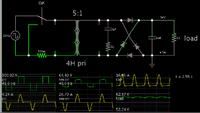T
treez
Guest
Hello,
If we have a cheap inverter which produces a rough 'stair-step' type mains waveform, then presumably if it used to supply equipment which comprises a mains transformer, then the mains transformer primary inductance will filter the stair-step waveform to make it smooth...(ie make the current smooth)?
However, if the equipment being supplied by the cheap inverter's output was a switch mode power supply , then there would be more problems, as this stair-step voltage supply would cause heavy repeated inrush currents into the post rectifier bridge capacitor?
If we have a cheap inverter which produces a rough 'stair-step' type mains waveform, then presumably if it used to supply equipment which comprises a mains transformer, then the mains transformer primary inductance will filter the stair-step waveform to make it smooth...(ie make the current smooth)?
However, if the equipment being supplied by the cheap inverter's output was a switch mode power supply , then there would be more problems, as this stair-step voltage supply would cause heavy repeated inrush currents into the post rectifier bridge capacitor?
